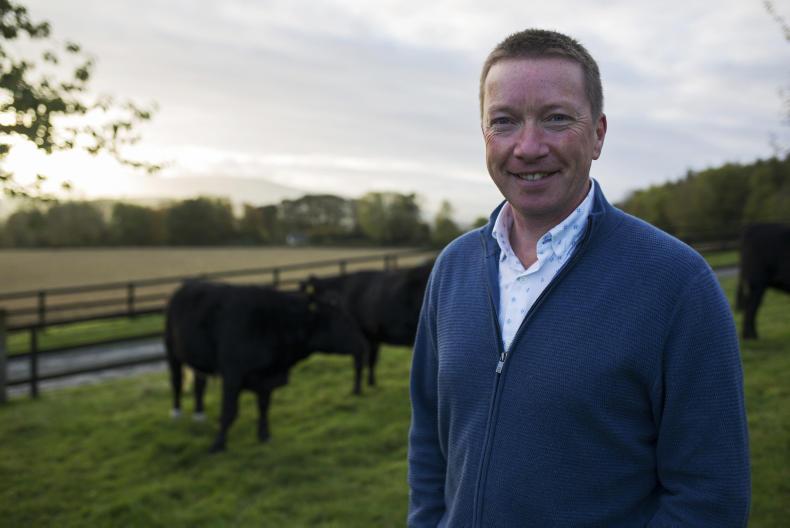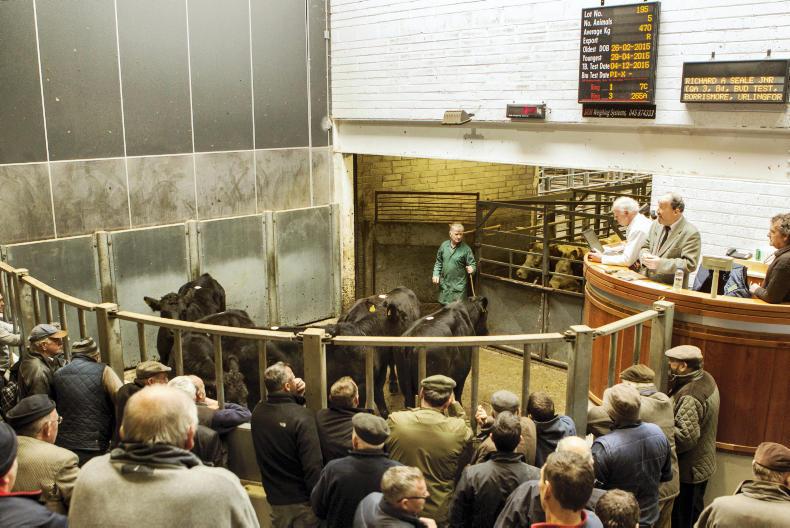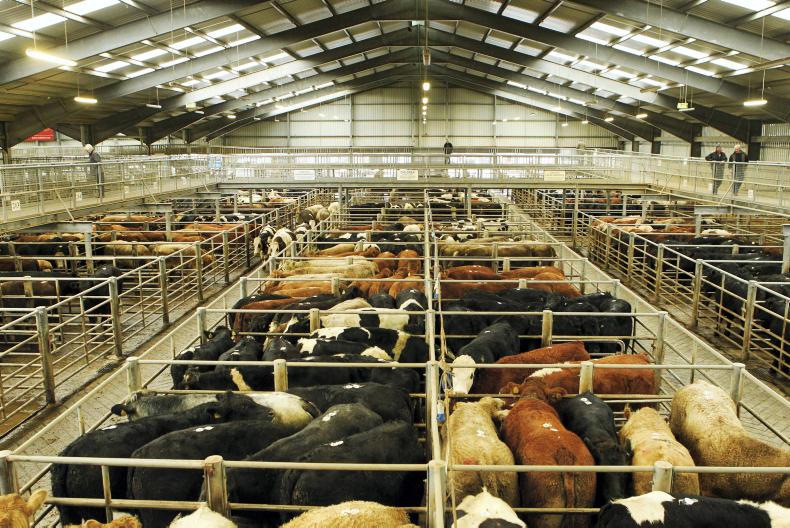The mart sector has faced its fair share of challenges with compliance with the Property Services (Regulation) Act 2011 the standout encounter of recent years.
However, there are numerous other challenges that have been bubbling away in the background.
While some remain, Ray Doyle, ICOS marts executive, says there have been a number of good developments in the mart sector over the last 12 months.
Auctioneering course
The introduction of the Property Services (Regulation) Act in 2011 significantly tightened credit control in the marts business. However, another consequence of the act that has not been underlined is the effect it has had on recruiting new livestock auctioneers.
Ray explains that when the act was introduced, livestock auctioneers were brought under the same banner as all auctioneers.
The only exception to this were long-service livestock auctioneers who were granted an exemption. This meant that anyone wishing to become a livestock auctioneer since 2011 had to complete a minimum two-year degree course based on property, not livestock.
While there are lots of graduates who have completed this course, there have not been many graduates interested in livestock auctioneering, which compounded issues in what was already an aging workforce.
This, thankfully, changed in the last year with an avenue now available for interested parties. Anyone with a Level 6 Green Cert and a new 30-credit distance learning course can become a livestock auctioneer.
“ICOS lobbied hard with the PSRA to get this rule changed on the basis that many of the people interested in becoming a livestock auctioneer were not interested or did not have the necessary qualifications in doing a two-year degree course based on property only.
"The PSRA CEO Maeve Hogan thankfully understood our case and was willing to work with us.
"The next step was to get a qualification accredited and we are indebted to the Institute of Professional Auctioneers and Valuers (IPAV) for accrediting the course and to Tallaght IT for providing the course.
"We have the first intake of livestock auctioneers graduating in the coming weeks and will have another intake in September.”

Ray Doyle, ICOS marts executive.
While the course is completed through Tallaght IT, the fact that it is distance learning means participants can work largely from their own base and only need to spend a number of days in Dublin.
The cost of the Tallaght/IPAV course is dependent on the number enrolled but is in the region of €2,500.
While on the subject of the PSRA, Ray says that it is great to see all marts now licensed.
“There is no doubt that many marts were challenged in meeting the standards required to comply with the Property Services Act, but doing so has meant that marts and all those buying or selling are now in a much stronger trading position.
"I would continue to urge farmers to ensure their mart is compliant and trade with licensed marts.”
Quality assurance
Ray highlights quality assurance as a logical progression for marts pointing out that the majority of marts are already trading at a very high standard.
“We have agreed with Bord Bia that they will create a format for a Quality Assurance Scheme for marts."
This will be developed in the coming months and we hope to have it up and running inside the next 12 months.
"This is something that is already in place in the UK with marts tying into the Red Tractor scheme and when in place in Ireland will standardise services across all participating marts.”
In addition to quality assurance, ICOS is also working with Coop Italia to ensure smooth operation of their recent announcement to source Irish animals that have never received antibiotic treatment or consumed GM origin feed ingredients.
“We can see why Coop Italia has set a precedent for Irish weanlings given the low antibiotic usage on suckler farms.
"ICOS has met with the two main software companies and we are investigating workable and practical solutions of collecting the information.
"Additionally, we have met Coop Italia directly to investigate the feasibility and practicality of collecting this information and are working to develop straight forward solutions.”
‘‘Farmers will be asked to sign a declaration, most likely in the coming weeks, and it is important to be aware that it will be the producers’ responsibility to declare if animals have ever received antibiotic treatment.
‘‘All the talk has been on the potential that this presents for live exports, which is fantastic, but it will also provide a very important service for the Irish finishers of Coop Italia-destined animals which are currently supplying over 30,0000 antibiotic and GM feed-free cattle for slaughter by Irish meat plants.”
Two areas which continue to provide a major challenge to the mart sector are rising insurance costs and council rates.
“One of the greatest issues marts will face in the coming years is the ability to pay their insurance bills.
"Costs are rising rapidly due to increase in the cost of claims. With this in mind, marts managers need to prioritise managing safety and stop unsafe working practices if they want to achieve lower insurance rates."
The key area of concern is the interaction of livestock and members of the public in the intake, loading and lairage area and it is imperative that this risk is managed so it prevents injury claims.
‘‘Some marts have got around this by installing overhead walkways or designated safety areas, while some marts have taken the approach of closing the lairage or central passageway area to mart staff only, while the sale is taking place.
"It’s not that marts want to be awkward to its customers, but with insurance costs rising to €20,000 and in cases as high as €50,000 where there may have been claims, something will have to change,’’ Ray says.

"The changes need to be significant enough so as to reduce the likelihood of injury and resulting claims.
"In French marts, for example, farmers are not allowed to enter or handle cattle once they have been unloaded at the intake point,” he adds.
Training
Drover training and visibility of drovers and management personnel in marts is something Ray says is high on the agenda of insurance companies.
He says that ICOS has been working with the support of FBD to develop a mart health and safety DVD and material which will be available in the coming weeks.
ICOS and FBD have also worked very closely with the HSA to produce an online safety statement for marts.
This is a free tool which can be accessed at www.besmart.ie. Some marts have also had to take the step of installing CCTV cameras to ensure that accidents or malicious behaviour can be accounted for accurately.
Animal welfare
Another aspect that everyone involved in mart trading also has to be mindful of is animal welfare. This is becoming a growing focal point globally and marts must continue to ensure high standards are maintained.
“We have trialled using paddles over sticks with drovers and this is something we are looking to get implemented in more marts."
"These changes need to be led from the top down in marts and there is an onus on mart management to also ensure that improper handling of animals from buyers and sellers is addressed by mart employees," according to Ray.
Rising council rates have come under the spotlight due to a process of rates equalisation being enforced by local authorities.
In its simplest explanation, this is where rates charged to commercial businesses are being equalised across regions, meaning that a mart located in a small town or on the edge of a town could face higher rates relative to what is charged to a mart located in a busy commercial area.
Typical rates in small towns are €15,000 to €20,000 per year, while this figure can rise to €50,000 where marts are located in a busy area.
Ray says that there is no logic to marts being charged the same rates as other businesses given that many only operate on a couple of days a week.
“Marts are seen as purely commercial businesses. We cannot argue that they are commercial enterprises but marts also provide a strong social and community service.
"On any particular day, mart attendance could be made up by over 70% of people who are not trading animals and are there for the social interaction.
"Marts are also the focal point for many meetings and provide a valuable social service to their rural communities.
"We have and continue to push for this to be taken into account in budget submissions, along with taking into account actual trading times,” Ray says.
Read more
Heavy cattle resistant to price drops
Farmers to be locked into their seats at marts
The mart sector has faced its fair share of challenges with compliance with the Property Services (Regulation) Act 2011 the standout encounter of recent years.
However, there are numerous other challenges that have been bubbling away in the background.
While some remain, Ray Doyle, ICOS marts executive, says there have been a number of good developments in the mart sector over the last 12 months.
Auctioneering course
The introduction of the Property Services (Regulation) Act in 2011 significantly tightened credit control in the marts business. However, another consequence of the act that has not been underlined is the effect it has had on recruiting new livestock auctioneers.
Ray explains that when the act was introduced, livestock auctioneers were brought under the same banner as all auctioneers.
The only exception to this were long-service livestock auctioneers who were granted an exemption. This meant that anyone wishing to become a livestock auctioneer since 2011 had to complete a minimum two-year degree course based on property, not livestock.
While there are lots of graduates who have completed this course, there have not been many graduates interested in livestock auctioneering, which compounded issues in what was already an aging workforce.
This, thankfully, changed in the last year with an avenue now available for interested parties. Anyone with a Level 6 Green Cert and a new 30-credit distance learning course can become a livestock auctioneer.
“ICOS lobbied hard with the PSRA to get this rule changed on the basis that many of the people interested in becoming a livestock auctioneer were not interested or did not have the necessary qualifications in doing a two-year degree course based on property only.
"The PSRA CEO Maeve Hogan thankfully understood our case and was willing to work with us.
"The next step was to get a qualification accredited and we are indebted to the Institute of Professional Auctioneers and Valuers (IPAV) for accrediting the course and to Tallaght IT for providing the course.
"We have the first intake of livestock auctioneers graduating in the coming weeks and will have another intake in September.”

Ray Doyle, ICOS marts executive.
While the course is completed through Tallaght IT, the fact that it is distance learning means participants can work largely from their own base and only need to spend a number of days in Dublin.
The cost of the Tallaght/IPAV course is dependent on the number enrolled but is in the region of €2,500.
While on the subject of the PSRA, Ray says that it is great to see all marts now licensed.
“There is no doubt that many marts were challenged in meeting the standards required to comply with the Property Services Act, but doing so has meant that marts and all those buying or selling are now in a much stronger trading position.
"I would continue to urge farmers to ensure their mart is compliant and trade with licensed marts.”
Quality assurance
Ray highlights quality assurance as a logical progression for marts pointing out that the majority of marts are already trading at a very high standard.
“We have agreed with Bord Bia that they will create a format for a Quality Assurance Scheme for marts."
This will be developed in the coming months and we hope to have it up and running inside the next 12 months.
"This is something that is already in place in the UK with marts tying into the Red Tractor scheme and when in place in Ireland will standardise services across all participating marts.”
In addition to quality assurance, ICOS is also working with Coop Italia to ensure smooth operation of their recent announcement to source Irish animals that have never received antibiotic treatment or consumed GM origin feed ingredients.
“We can see why Coop Italia has set a precedent for Irish weanlings given the low antibiotic usage on suckler farms.
"ICOS has met with the two main software companies and we are investigating workable and practical solutions of collecting the information.
"Additionally, we have met Coop Italia directly to investigate the feasibility and practicality of collecting this information and are working to develop straight forward solutions.”
‘‘Farmers will be asked to sign a declaration, most likely in the coming weeks, and it is important to be aware that it will be the producers’ responsibility to declare if animals have ever received antibiotic treatment.
‘‘All the talk has been on the potential that this presents for live exports, which is fantastic, but it will also provide a very important service for the Irish finishers of Coop Italia-destined animals which are currently supplying over 30,0000 antibiotic and GM feed-free cattle for slaughter by Irish meat plants.”
Two areas which continue to provide a major challenge to the mart sector are rising insurance costs and council rates.
“One of the greatest issues marts will face in the coming years is the ability to pay their insurance bills.
"Costs are rising rapidly due to increase in the cost of claims. With this in mind, marts managers need to prioritise managing safety and stop unsafe working practices if they want to achieve lower insurance rates."
The key area of concern is the interaction of livestock and members of the public in the intake, loading and lairage area and it is imperative that this risk is managed so it prevents injury claims.
‘‘Some marts have got around this by installing overhead walkways or designated safety areas, while some marts have taken the approach of closing the lairage or central passageway area to mart staff only, while the sale is taking place.
"It’s not that marts want to be awkward to its customers, but with insurance costs rising to €20,000 and in cases as high as €50,000 where there may have been claims, something will have to change,’’ Ray says.

"The changes need to be significant enough so as to reduce the likelihood of injury and resulting claims.
"In French marts, for example, farmers are not allowed to enter or handle cattle once they have been unloaded at the intake point,” he adds.
Training
Drover training and visibility of drovers and management personnel in marts is something Ray says is high on the agenda of insurance companies.
He says that ICOS has been working with the support of FBD to develop a mart health and safety DVD and material which will be available in the coming weeks.
ICOS and FBD have also worked very closely with the HSA to produce an online safety statement for marts.
This is a free tool which can be accessed at www.besmart.ie. Some marts have also had to take the step of installing CCTV cameras to ensure that accidents or malicious behaviour can be accounted for accurately.
Animal welfare
Another aspect that everyone involved in mart trading also has to be mindful of is animal welfare. This is becoming a growing focal point globally and marts must continue to ensure high standards are maintained.
“We have trialled using paddles over sticks with drovers and this is something we are looking to get implemented in more marts."
"These changes need to be led from the top down in marts and there is an onus on mart management to also ensure that improper handling of animals from buyers and sellers is addressed by mart employees," according to Ray.
Rising council rates have come under the spotlight due to a process of rates equalisation being enforced by local authorities.
In its simplest explanation, this is where rates charged to commercial businesses are being equalised across regions, meaning that a mart located in a small town or on the edge of a town could face higher rates relative to what is charged to a mart located in a busy commercial area.
Typical rates in small towns are €15,000 to €20,000 per year, while this figure can rise to €50,000 where marts are located in a busy area.
Ray says that there is no logic to marts being charged the same rates as other businesses given that many only operate on a couple of days a week.
“Marts are seen as purely commercial businesses. We cannot argue that they are commercial enterprises but marts also provide a strong social and community service.
"On any particular day, mart attendance could be made up by over 70% of people who are not trading animals and are there for the social interaction.
"Marts are also the focal point for many meetings and provide a valuable social service to their rural communities.
"We have and continue to push for this to be taken into account in budget submissions, along with taking into account actual trading times,” Ray says.
Read more
Heavy cattle resistant to price drops
Farmers to be locked into their seats at marts









SHARING OPTIONS